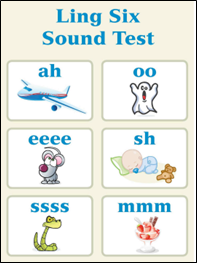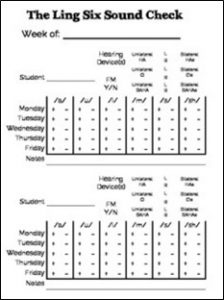 Why Should the Ling Sound Test be done at school?
Why Should the Ling Sound Test be done at school?
Question from the field: Can you please clarify the reason for the LING sound test. Why do families want us to do this at school, and how can we implement this without stressing out the general education teachers?
| The reason we do a daily listening check is purely and for the sole purpose of ensuring that our students’ personal and classroom technology is working and that they have full and clear access to their instruction. |
The Ling Sounds let us know how our students are both accessing and discriminating sounds across the speech spectrum. The purpose of conducting this listening check is not for us to check the student’s personal listening abilities, and it is not a time for us to work on their auditory skills or IEP goals.
As Carol Flexer teaches us, we do not hear with our ears. We hear with our brains. “Hearing loss is a doorway problem… there is some type and amount of obstruction in this ear doorway that prevents auditory data from the environment to reach the brain where learning the meaning of that auditory information occurs. Hearing aids and cochlear implants break through the doorway to allow access, stimulation, and development of auditory neural pathways.”1 We do the daily Ling sounds listening check in order to ensure that the child has clear access through their technology (personal and classroom) to their brain prior to starting each day.
The LING Sound Check:
WHAT?
The Ling Sounds were identified by Daniel Ling. They are “ah” “oo” “ee” “s” “sh” and “m” We know that when a child can detect all 6 of these sounds, they have access to sounds from 250 Hz to 8000 Hz. When they can discriminate all 6 of these sounds, we know that they are ready to learn.
WHY?
We as educators are responsible for our students’ access to their instruction in the educational setting. We must ensure that before instruction starts, we are aware of any auditory limitations that the student may have on any given day. By doing the daily listening check, we may identify confusion of low frequencies such as “oo” and “m” or difficulty with high frequency information such as “s” and “sh.” We may see a pattern of difficulty that is reflective of equipment issues that has nothing to do with the child’s effort or how much he or she is paying attention. For example, if a child is not clearly able to perceive the “s” sound they could be unable to differentiate between cat, cap, cast, calf, etc. If the access issue is not as simple as a battery or that the child has a cold that day, then the information is shared with the teacher as well as the family who may then decide to follow up with their clinical audiologist.
WHO?
For most teams the general education classroom teacher will not be the one to conduct the listening checks as they have many other students and responsibilities at the beginning of each school day. This is not necessarily a task or responsibility that we want to add to the general education teacher’s load. We do want them to understand what it is and why we do it. Teams will typically identify a primary person on the school site who will be trained how to conduct the listening checks as well as training some back up personnel on campus. Examples of staff who may conduct the listening checks are a SPED teacher, SLP, classroom aide, school nurse or health tech, or a 1:1 aide. This is a good discussion to have as a team so that the Teacher of the Deaf and Educational Audiologist can train the appropriate team members.
WHEN?
It is important that the listening checks be done prior to instruction at the start of school. It only takes a few minutes and should always be done before instruction begins.
WHERE?
The listening checks must be done in a quiet location. It may be in a classroom before the other students enter, the nurse’s office, outside of the classroom after the students have all left the playground, or wherever the team identifies as an appropriate location with minimal auditory distractions or interference.
HOW?
In my experience the listening checks are done as follows:
- The student is facing away from the adult. Most teams will assess at ear level, 3 feet, and 6 feet.
- The adult says the 6 Ling sounds and sometimes includes silence.
- It is imperative that the sounds are never done in the same order from one day to the next as our students are masters at knowing what comes next
- The person conducting the listening check will put a check mark ✅ if the child gets the sound correct on the first attempt, “2nd,” if they get it correct the second time, and document2 the sound the child says (ie: “m” for “oo”) if they said it wrong.
WHAT NOT TO DO:
Do not ever do the following while conducting a Ling sound listening check:
- 1. Continue to repeat the sound until the student gets it right.
- 2. Turn the child to face us if they are saying the wrong sound.
- 3. Let the student know that they missed a sound. We want to say, “Listen again” and “Great job” and send them off to class. Remember that are checking the equipment and access, not the student.
The reasons we do the daily Ling sound listening checks are so that the we can confirm the equipment is working, so the educators know the student is ready to learn, and to inform the family if the equipment is not working in case they need to follow up with their clinical audiologist. Our students should not feel like they have failed or done anything wrong as this is not a time when we are working on their skills or IEP goals.
Melinda GilLinger, M. A.
Special Education Consultant
www.melindagilLinger.com
- 1. How to Grow a Young Child’s Listening Brain, Carol Flexer, PhD, CCC-A, LSLS Cert. AVT 6/26/2018
- 2. Suggested resource to document the Ling Six Sound Check: https://www.teacherspayteachers.com/Product/The-Ling-6-Sound-Check-1729553
